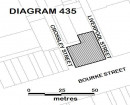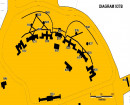GELLIBRAND PIER AND BREAKWATER PIER
NELSON PLACE AND BATTERY ROAD WILLIAMSTOWN, HOBSONS BAY CITY
-
Add to tour
You must log in to do that.
-
Share
-
Shortlist place
You must log in to do that.
- Download report
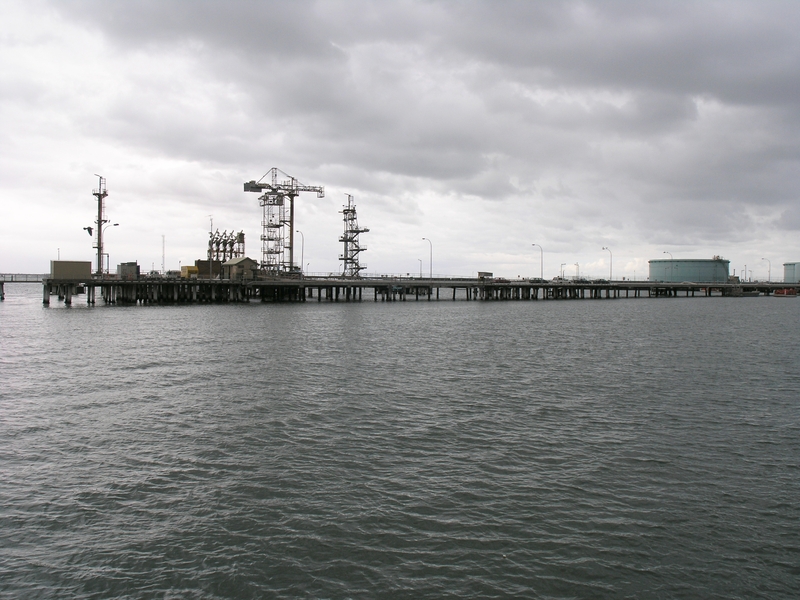

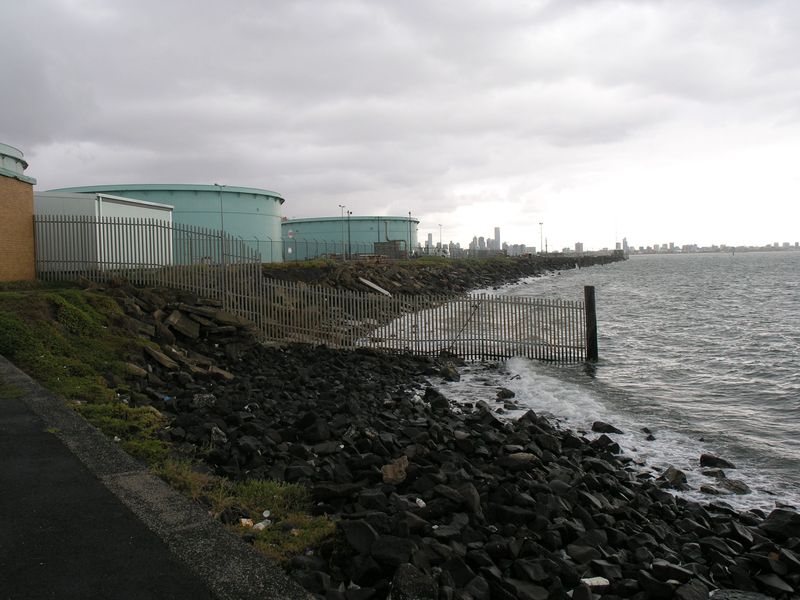
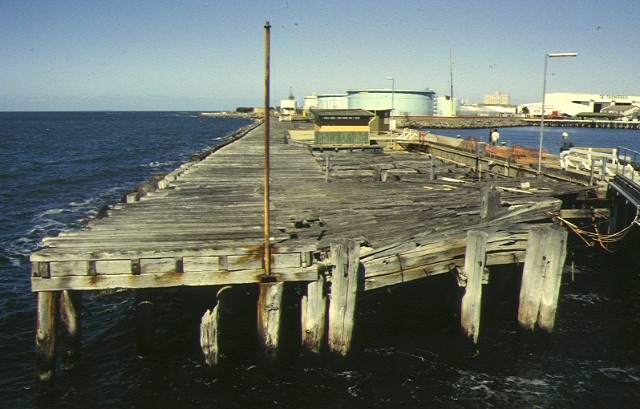

Statement of Significance
What is significant?
Breakwater Pier was constructed as a timber breakwater with an embanked approach from 1859 to 1861 by contractors McKay and McDonald. The Pier, which incorporated an earlier (1857) octagonal tide gauge house, was constructed over an existing stone pier which had been built by convicts in 1852-53. The pier structure was designed as a two level structure on the landward end to allow access to the tide gauge house on one level with the railway on the other level. The seaward end of the pier was of uniform height. The docking area was on the sheltered western side with ships using a series of sawtooth berths. The side of the pier was straightened in the 1880s and it was lengthened in 1933-34. The pier was remodelled in 1954 to take tankers, at which time the tide gauge house relocated to Commonwealth Reserve, Williamstown.
The Gellibrand Railway Pier was constructed between 1854 and 1859 by the Melbourne Mount Alexander and Murray River Railway Company. The first stage of the work, undertaken by contractors Musson and Bourne, involved the construction of a solid embankment, some 244 metres long, into the bay, part of which is now covered by the approaches of the existing pier. In 1857 contractors Evans Merry & Co built a 183 metre timber extension. The original two major wings on each side of the Pier were altered and extended until their removal sometime between the early 1880s and 1894. The Pier was remodelled and extended in 1963 to take tankers.
How is it significant?
Breakwater Pier and Gellibrand Pier have historic significance to the State of Victoria.
* Breakwater Pier, with the modifications that have taken place over time, demonstrates the changing functions and uses of the site from its original purpose as a convict jetty, to a timber breakwater, to the site for the tide gauge house, to a railway pier playing an important role in the wool and grain trade and to its current role in handling exports and imports for the oil and petrochemical industry in Victoria.
*Gellibrand Pier, with the alterations and extensions that have taken place through its history, demonstrates the changing functions and uses of the pier from its original purpose as an important element of the Melbourne to Williamstown railway line and its role in the grain and wool trade to its current role in handling the exports and imports of the oil and petrochemical industry of Victoria.
* Breakwater Pier, along with Gellibrand Pier, has an association with Point Gellibrand. Both structures had a major impact on the success and prominence of the Point in the early maritime history of Victoria.
* Breakwater Pier, thought to include the original convict jetty in its structure, has an association with the prison hulks moored off Point Gellibrand between the 1850s until the 1880s. These hulks played an important role in the early history of the prison system. This was the first jetty to be constructed at Point Gellibrand and possibly one of the first structures to be built by the convicts.
Together with the Gellibrand Pier, Breakwater Pier is associated with the economic growth of Victoria. It played an important role as a grain and wool port from the 1850s until the 1930s.
The tank farm, located between Gellibrand and Breakwater Piers, has and association with the boat harbour at Point Gellibrand which was probably formed in the 1880s. It comprised curved stoned groynes constructed out from each of the piers to create a sheltered harbour. The area was land filled in the 1950s to make way for the construction of oil storage tanks and much of the early stone and earth embankments to the piers are now obscured.
The Gellibrand Railway Pier demonstrates an association with the economic growth of Victoria. The pier, one of the earliest major shipping piers on Hobsons Bay, was of great importance to the wool and grain trade. The pier was an important element in the Melbourne Williamstown railway line. This line facilitated the import and export of goods to and from ships in the bay. The remnant rail tracks on the Pier are important to an understanding of the history of the site.
The extensive use of dressed stone in the Pier is believed to be unique in Victoria and a contrast to later Australian practice in the construction of piers.
The importance of the Pier is heightened by the survival of part of its original structure. The most substantial visible part of the original structure is the dressed basalt retaining wall at the end, and to part of, the west side of the embankment. The basic layout of the railway tracks is original and some elements of the timber structure would seem to date from 1845.
-
-
GELLIBRAND PIER AND BREAKWATER PIER - History
History of Place
Point Gellibrand was used as a landing place for stock by early European arrivals in the Port Phillip District. Early Government maritime infrastructure was established nearby as the point offered some shelter for landing passengers and cargo and the waters off Point Gellibrand offered suitable anchorage for larger vessels visiting Hobson's Bay. By 1841, when a government jetty had been constructed nearby at Williamstown, a plain oil-burning light had been erected by order of Governor Bourke at Point Gellibrand. Governor Bourke had also ordered that a battery be constructed at Point Gellibrand for the defence of the young settlement on the Yarra, but this was not begun until the 1850s.
By this time a Select Committee on the Ports of Melbourne and Geelong had recommended that wharves and a breakwater be constructed at Point Gellibrand.
Lieutenant-Governor Charles La Trobe proclaimed the 'parcel of land' known as Gellibrand's Point as a penal establishment on February 16, 1853, two weeks after two vessels, the President and the Deborah, which were moored in Hobson's Bay, were declared public prisons and Gellibrand's Point had been proclaimed as the place of landing and disembarking prisoners from these vessels. In June of 1853, the Success became the third hulk to be declared a public prison in Hobsons Bay. In 1854 the Sacramento and Lysander were also declared prison hulks. They were to be moored northward of the lighthouse at Gellibrand's Point.
Prisoners from the hulks were engaged in a number of tasks at Point Gellibrand, including quarrying stone, laying out tramways, building a defence battery and constructing a prisoners' jetty. (Return showing the description, quantity and value of work performed by convict labour at Gellibrand's Point, Williamstown, from the 1st to the 31st October, 1855, VPP 1855/56, Vol.1 p. 361).
Gellibrand Pier (known until 1923 as Railway Pier or Old Railway Pier) was constructed between 1854 and 1859, the year in which it was declared a legal wharf. Construction began under the auspices of the Melbourne, Mount Alexander and Murray River Railway Company, which planned to construct railway lines linking Melbourne and the port at Williamstown to Bendigo and the Murray River.
Work on the pier began at the same time as work on the railway line and consisted of the construction of an earthen embankment run out into the bay. Later contracts extended the pier in timber. The final contractors, Porter and Robinson, enclosed the earthen embankment in bluestone walls (Argus, 17 November, 1859, p.5) The private railway company ran out of funds in 1856, prompting the Victorian Government to take over the partially-completed railway line and pier. From September 1857, however, trains running from Geelong to Melbourne terminated at the Railway Pier and passengers completed their journey to Melbourne by steamer. A temporary station was located at the pier. The Victorian Railways Department's first railway workshops were established at Point
Gellibrand in 1857 and remained on this site until the opening of the Newport Railway Workshops in the 1880s.
Before the Railway Pier was completed the Victorian Government had voted to extend the prisoner's jetty at Point Gellibrand to form a breakwater for the railway pier. The existing bluestone jetty was to be extended 1000 feet in a northerly direction. M.L McKay won the contract to complete the breakwater, which would not only serve as a breakwater, but also afford a 'steam basin for the use of colonial steamers' as well as allowing vessels to lie alongside and discharge cargoes during the heaviest of gales (Argus, 11 May, 1859, p.4). A bluestone tide gauge house was erected on the shore end of Breakwater Pier. By the 1880s a boat harbour, partially enclosed with stone groynes, was located between Railway and Breakwater Piers.
From the 1880s, the Melbourne Harbor Trust dredged channels from the piers to the main shipping channel in Port Phillip Bay and dredged around the piers to enable vessels of ever-increasing size to tie up at the piers. In 1899 the piers were dredged to a depth of 28 feet (MHT Commissioners Annual Report, 1899). In 1931, they were dredged to a depth of 32 feet (MHT Commissioners General Plan of the Port of Melbourne).
The Victorian Railways Department managed Gellibrand and Breakwater piers until 1913, when the Melbourne Harbor Trust assumed responsibility for these and the Railway Pier at Port Melbourne. A third railway pier (later called Nelson Pier) was constructed at Williamstown in 1878 and the three piers were used entirely for railways purposes until they passed into the hands of the MHT. Connected to the country and suburban rail network, by the first decade of the twentieth century the three railway piers at Williamstown were used 'almost entirely' for exports. While some wool was exported from the piers, the bulk of the export cargo was wheat (Ferguson, p. 8). In the 1920s a state government-appointed board recommended that grain elevators be established at several Victorian country railway stations, with grain terminals built at the Port of Geelong and at the railway piers at Williamstown. The elevator and terminal building at Geelong, together with a grain handling pier, were begun in 1936. Work began on the Williamstown terminal in 1938, but only the foundations and basement were completed. During World War II the Melbourne Harbor Trust converted these foundations into air raid shelters for port workers at the nearby dockyards and workshops.
In the 1950s the Standard Vacuum Oil Company, building a new oil refinery at Altona, reclaimed four and a half acres of land from the boat harbour between Gellibrand and Breakwater Piers and erected oil storage tanks there. At the same time, Breakwater Pier was extensively extended and remodelled to enable the delivery of crude oil at the pier. The tide gauge was removed to a new building on the Ann Street pier in 1946, when it was found that its location on Breakwater Pier did not allow adequate communication with open water (MHT Commissioners' Report 1946, p.71). The bluestone tide gauge house was moved to the Commonwealth Reserve in Nelson Place, Williamstown some time after this.
Sources:
Argus
Victorian Government Gazette
Victorian Parliamentary Papers
Jill Barnard, Jetties and Piers a background history of maritime infrastructure in Victoria, Heritage Council of Victoria, 2008.
Wm Ferguson, 'Report on the Port of Melbourne', 1908, VPP 1908, Vol.2
Melbourne Harbor Trust Commissioners' Annual Reports
Return showing the description, quantity and value of work performed by convict labour at Gellibrand's Point, Williamstown, from the 1st to the 31st October, 1855, VPP 1855/56, Vol.1 p. 361.
GELLIBRAND PIER AND BREAKWATER PIER - Permit Exemptions
General Exemptions:General exemptions apply to all places and objects included in the Victorian Heritage Register (VHR). General exemptions have been designed to allow everyday activities, maintenance and changes to your property, which don’t harm its cultural heritage significance, to proceed without the need to obtain approvals under the Heritage Act 2017.Places of worship: In some circumstances, you can alter a place of worship to accommodate religious practices without a permit, but you must notify the Executive Director of Heritage Victoria before you start the works or activities at least 20 business days before the works or activities are to commence.Subdivision/consolidation: Permit exemptions exist for some subdivisions and consolidations. If the subdivision or consolidation is in accordance with a planning permit granted under Part 4 of the Planning and Environment Act 1987 and the application for the planning permit was referred to the Executive Director of Heritage Victoria as a determining referral authority, a permit is not required.Specific exemptions may also apply to your registered place or object. If applicable, these are listed below. Specific exemptions are tailored to the conservation and management needs of an individual registered place or object and set out works and activities that are exempt from the requirements of a permit. Specific exemptions prevail if they conflict with general exemptions. Find out more about heritage permit exemptions here.Specific Exemptions:PREAMBLE TO PERMIT EXEMPTIONS
The intent of these permit exemptions is to conserve the 1857-1870s timber portions of Gellibrand Pier (if any survive) and the dressed bluestone section (1854-1870s) of Gellibrand Pier (including the concealed portions now buried beneath the Pier approaches)
As some significant fabric is buried beneath existing structures and the works, the intent is to exercise permit control over construction work that may involve subsurface excavation.
The construction of buildings and works atop the post 1960 concrete structure, as shown of the attached plan, is not considered to be detrimental to the conservation of the pier’s significance
EXEMPTION FROM PERMIT:
· Any works in the tank farm area not involving impact upon the Gellibrand Pier
· Removal of post 1930 structures
· Works to existing and any new concrete structures
· Works to all post 1930 structures
· Removal of existing pipelines and pipework supports anywhere on Gellibrand Pier and its approach embankment.
· Construction of new pipe supports.
· Construction of buildings and works along the approach embankment of Gellibrand Pier.
· Pile driving.
· Placement of fenders.
· Replacement of twentieth century piles and other structural members,
· Replacement of 1857 – 1870s timber piles and other structural members that can be identified as such or are likely to date from that period with new substitute elements of similar dimensions.
CONDITIONS:
1. Exempt classes of works or activities are to be planned and carried out in a manner which prevents damage to the registered place / object. However, if other previously hidden original or inaccessible details of the object or place are uncovered, any works that may affect such items shall immediately cease. The Executive Director shall be notified of the details immediately to enable Heritage Victoria representatives to inspect and record the items, and for discussion to take place on the possible retention of the items, or the issue of a modified approval.
2. If there is a Conservation Policy and Plan approved by the Heritage Council or Executive Director, all works and activities shall be carried out in accordance with that Policy and Plan.
3. Nothing in this Declaration prevents the Executive Director from amending or rescinding all or any of the permit exempt alterations provided work has not commenced on the alteration.
THE ATTENTION OF THE OWNER AND/OR APPLICANT IS DRAWN TO THE NEED TO OBTAIN ALL OTHER RELEVANT PERMITS PRIOR TO THE COMMENCEMENT OF WORKS.GELLIBRAND PIER AND BREAKWATER PIER - Permit Exemption Policy
Pursuant to Section 66(1) of the Heritage Act (1995) and in respect to the above-registered place / object, the Executive Director hereby DECLARES EXEMPT THE OWNERS NEED TO OBTAIN A PERMIT TO CARRY OUT ANY OF THE FOLLOWING CLASSES OF WORKS OR ACTIVITIES, SUBJECT TO ANY CONDITIONS PRESCRIBED HEREUNDER:
-
-
-
-
-
FORMER MORGUE
 Victorian Heritage Register H1512
Victorian Heritage Register H1512 -
TIME BALL TOWER
 Victorian Heritage Register H1649
Victorian Heritage Register H1649 -
WILLIAMSTOWN RAILWAY STATION COMPLEX
 Victorian Heritage Register H1599
Victorian Heritage Register H1599
-
'NORWAY'
 Boroondara City
Boroondara City -
1 Mitchell Street
 Yarra City
Yarra City
-
-






